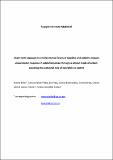Por favor, use este identificador para citar o enlazar a este item:
http://hdl.handle.net/10261/341796COMPARTIR / EXPORTAR:
 SHARE SHARE
 CORE
BASE CORE
BASE
|
|
| Visualizar otros formatos: MARC | Dublin Core | RDF | ORE | MODS | METS | DIDL | DATACITE | |

| Título: | Short-term exposure to environmental levels of nicotine and cotinine impairs visual motor response in zebrafish larvae through a similar mode of action: Exploring the potential role of zebrafish α7 nAChR |
Autor: | Bellot, Marina; Manen, Leticia; Prats, Eva CSIC ORCID ; Bedrossiantz, Juliette CSIC ORCID CVN ; Barata Martí, Carlos CSIC ORCID ; Gómez-Canela, Cristian CSIC ORCID; Antolin, Albert A.; Raldúa, Demetrio CSIC ORCID | Palabras clave: | Nicotinic acetylcholine receptor Behavior Cotinine Fish larvae Nicotine |
Fecha de publicación: | 20-feb-2024 | Editor: | Elsevier | Citación: | Science of The Total Environment 912: 169301 (2024) | Resumen: | The current view is that environmental levels of nicotine and cotinine, commonly in the ng/L range, are safe for aquatic organisms. In this study, 7 days post-fertilization zebrafish embryos have been exposed for 24 h to a range of environmental concentrations of nicotine (2.0 ng/L-2.5 μg/L) and cotinine (50 pg/L–10 μg/L), as well as to a binary mixture of these emerging pollutants. Nicotine exposure led to hyperactivity, decreased vibrational startle response and increased non-associative learning. However, the more consistent effect found for both nicotine and cotinine was a significant increase in light-off visual motor response (VMR). The effect of both pollutants on this behavior occurred through a similar mode of action, as the joint effects of the binary mixture of both chemicals were consistent with the concentration addition concept predictions. The results from docking studies suggest that the effect of nicotine and cotinine on light-off VMR could be mediated by zebrafish α7 nAChR expressed in retina. The results presented in this study emphasize the need to revisit the environmental risk assessment of chemicals including additional ecologically relevant sublethal endpoints. | Versión del editor: | https://doi.org/10.1016/j.scitotenv.2023.169301 | URI: | http://hdl.handle.net/10261/341796 | DOI: | 10.1016/j.scitotenv.2023.169301 | ISSN: | 00489697 |
| Aparece en las colecciones: | (IDAEA) Artículos |
Ficheros en este ítem:
| Fichero | Descripción | Tamaño | Formato | Existing users please Login |
|---|---|---|---|---|
| 1-s2.0-S0048969723079317-main.pdf | Artículo principal | 5,24 MB | Adobe PDF | Embargoed until 1 de febrero de 2026 Petición de una copia |
| 1-s2.0-S0048969723079317-mmc1.pdf | Material suplementario | 221,66 kB | Adobe PDF |  Visualizar/Abrir |
CORE Recommender
SCOPUSTM
Citations
2
checked on 23-abr-2024
Page view(s)
11
checked on 27-abr-2024
Download(s)
3
checked on 27-abr-2024
Google ScholarTM
Check
Altmetric
Altmetric
NOTA: Los ítems de Digital.CSIC están protegidos por copyright, con todos los derechos reservados, a menos que se indique lo contrario.


